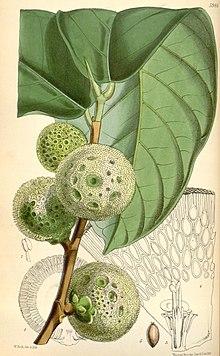Okwa tree
| Okwa tree | ||||||||||||
|---|---|---|---|---|---|---|---|---|---|---|---|---|

Okwa tree ( Treculia africana ) |
||||||||||||
| Systematics | ||||||||||||
|
||||||||||||
| Scientific name | ||||||||||||
| Treculia africana | ||||||||||||
| Decne. ex Trécul |
The okwa tree or African breadfruit tree ( Treculia africana ) is a species of the genus Treculia within the mulberry family (Moraceae). The seeds are widely used as food in the area of distribution in Africa. The generic name honors Auguste Adolphe Lucien Trécul (1818-1896), a French botanist.
description
Vegetative characteristics
The okwa tree is a fast-growing, large, evergreen tree that reaches heights of 20 to 25, rarely up to 30 meters or more, and trunk diameters of 2 to 4 meters or more. The crown is expansive and dense. The thick bark is brownish to light gray and relatively smooth. The trunk is often corrugated at the base and sometimes twisted. The tree has a milky sap which then turns reddish.
The new shoots are red or yellow (" leaf distribution "). The opposite, short-stalked, simple and entire, mostly smooth leaves are leathery and lighter on the underside. The leaf blade is ovate or obovate to ovate lanceolate or elliptical and about 20 to 40 centimeters long and pointed or pointed or rounded, on top it is deep green and shiny. The pinnate nerve is lighter and the median artery protrudes below. The stipules fall off early. The young leaves are reddish.
Generative characteristics
The okwa tree is monoecious, mixed-sex ( monoecious ) or mostly dioecious, separate-sexed ( dioecious ). The whitish to yellowish flowers appear in axillary or lateral, golden inflorescences , the spherical, mostly unisexual, more or less stalked inflorescences have a diameter of 5–10 centimeters. The male inflorescences are smaller. The inflorescences are underlaid with several short, leathery bracts . Reduced male flowers can occur in the female inflorescences. The female flowers have a close-fitting, three- to four-part inflorescence or they are mostly absent, the protruding stigma is two-part and thread-like, the male flowers usually have two or three to five protruding stamens and a two- to five-lobed, tubular inflorescence . The flowers each have partly salver-plate-shaped bracts, which usually stand together in bundles.
The pumpkin-like fruit associations ( false fruits ) are large, green or yellow-green to brownish, round to ellipsoidal and fairly smooth to slightly wrinkled and knobby, with a diameter of about 20-40 centimeters or more and a weight of up to 9 to 25 kg. They contain up to about 6,500 edible, orange-brownish, egg-shaped to elliptical, grain-like , about 1–1.5 cm long seeds , they weigh up to 2.3 kg per fruit cluster. The seed coat is thin and easy to remove, the two edible cotyledons it contains are dimorphic, so one is larger than the other. The seeds lie in a slimy shell (fruit peel of the individual fruits) and the individual fruits are stored in a whitish to brownish or pink, spongy and inedible tissue (pulp), unevenly deep. The seeds contain hydrocyanic acid , tannins , oxalates and alkaloids , which is why the seeds should not be consumed raw, they must first be heat-treated.
distribution
Treculia africana is mainly found in West Africa from Senegambia to Angola , but is also common in Central Africa .
use
The seeds contain approx. 19% high quality protein , 15 to 19% fat , 40 to 45% starch in addition to 3 to 9% sugar , 3 to 5% raw fiber and about 2.5% mineral salts .
The pleasant-tasting seeds are eaten by the locals, and in Angola and St. Thomé you can even find them regularly in the markets. In West Africa a flour is made from it. This can be baked in a mixture with cassava , sago or okwa flour to make bread and pasta. An oil can also be pressed out of the seed content, which is then processed into margarine . The cultivation of the okwa tree is particularly encouraged in numerous development projects .
Systematics
Treculia africana was first published by Joseph Decaisne ex Auguste Trécul . Synonyms for Treculia africana Decne. ex Trécul are: Treculia affona N.E.Br. , Treculia africana var. Nitida Engl. , Treculia africana var. Engleriana (De Wild. & Th.Dur.) Engl. , Ficus whytei Stapf , Treculia erinacea A. Chev. nom. nudum, Treculia dewevrei De Wild. & Th.Dur. , Ficus welsitschii Miq.
Varieties of Treculia africana are:
- Treculia africana var. Africana
- Treculia africana var. Inversa Okafor
- Treculia africana var. Sambiranensis (Leandri) CC Berg
- Treculia africana var. Ilicifolia (Leandri) CC Berg
- Treculia africana var. Mollis (Engl.) J.Léonard
literature
- Wolfgang Franke : crop science . Thieme, Stuttgart / New York 1992, ISBN 3-13-530405-1 .
- A. Engler : Monographs of African Plant Families and Genera. I: Moraceae (excl. Ficus) , Engelmann, Leipzig 1898, p. 31 ff, 45-50, 76, 78, 80, archive.org
Web links
- Treculia africana from Useful Tropical Plants, accessed April 10, 2019.
- Treculia africana . In: U. Brunken, M. Schmidt, S. Dressler, T. Janssen, A. Thiombiano, G. Zizka: West African plants - A Photo Guide. Senckenberg Research Institute, Frankfurt am Main 2008.
Individual evidence
- ↑ JO Nwaigwe, BA Adejumo: Qualities Of African Breadfruit (Treculia Africana) Seed Flour As Influenced By Thermal Processing Methods And Duration. In: International Journal of Technology Enhancements and Emerging Engineering Research. Vol. 3, Issue 4, 2015, pp. 102-108, online (PDF), at semanticscholar.org, accessed on April 12, 2019.
